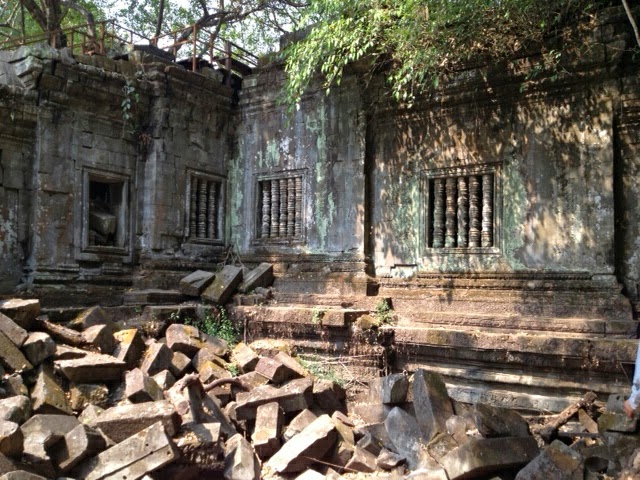The Khmer were one of the first modern peoples to establish themselves in Indochina, migrating down out of Central Asia around the second century AD. By the time the Laotians, Siamese, and Vietnamese moved into the regions they currently occupy, the Kingdom of Cambodia was a firmly established, powerful military state. Their culture was based around the Tonle Sap lake and its fertile seasonal floodplain, where their cities sat raised on wooden stilts to ride out the rainy season and their traditional festivals centered on strong rains and successful harvests. At the center of their cities rose great temples to the Hindu gods, built as earthly representations of the heavenly Mt. Meru and the only structures sacred enough to be built out of stone. As political fortunes waned and Khmer cities moved or were abandoned, everything rotted away except for the temples, and even they were lost to the jungle. It is these remaining monuments that we have come to Cambodia to see.
The Khmer civilization reached its height from the 900s through the 1200s, when their god-kings repeatedly moved the capital and embarked on aggressive building campaigns, each trying to outdo the devaraja before him. This has left monuments scattered over a broad swath of land; visiting colonials grouped 20-odd of them into a 'Grand Tour' when the sites were rediscovered and modern tour companies will follow the same route in one jam-packed day, but we decided to see fewer of the sites and take the time to fully explore each one while we were there. This was one of the locations I was most excited about in this entire global tour, so I wanted to do it well. We spent three days amongst the temples - the first at distant and secluded sites, the second within the walled city of Angkor Thom, and the final day at fabled Angkor Wat itself.
The two sites on our first day were a perfect introduction to Khmer architecture. The first, the diminutive Banteay Srei, is a perfectly preserved minor temple that has some of the finest stone carving in the world. It illustrated the standard layout and iconography of the Angkor temples while staying compact enough to be easily intelligible, and its fiery demons and gracefully dancing Apsara figures were in better condition than any others we saw.
As a fitting contrast, our second site for the day was as large as any at Angkor but has been completely overtaken by the jungle. Beng Mealea was an enormous square temple, complete with moat and stone causeway, monumental gates, four concentric rings of walled galleries, and a massive central tower. Much of this has collapsed and weathered away. What remains is the perfect Indiana Jones / tomb raider landscape of crumbling galleries, shattered towers, mossy piles of stone blocks concealing hidden rooms and carvings, and everywhere the jungle extending its roots and branches deeper into the structure. We clambered over rocks and through collapsing false arches here for hours, getting a feel for the organization and majesty of the Ankgorian temples. And just having a blast. Our tuk tuk driver seemed a bit exasperated at how long we had spent at the temple, but it gave us much to think about on the long drive home.
Our second day was the great walled city of Angkor Thom, located immediately adjacent to the more famous Wat and containing a host of temples and public buildings from the height of the empire. We walked its walls, climbed its reconstructed temples, explored an archeological site run by a Japanese team with a penchant for volleyball, and wandered through the elaborate carvings of elephants, demons, and gods that adorned the terraces fronting the public square. The main temple of the city was Bayon, thought to be one of the more bizarre temples in the area for the giant faces that adorn its towers. This whole area was literally flooded with tourists - bus loads and bus loads of them, from Japan and China and Vietnam and France - so most of the temples had been carefully cleaned and cordoned off to control the flow of people. Most of the buildings thus felt half-finished, with all the parts that had been crumbling carefully removed, leaving safer but incomplete monuments. They were majestic to see, but lacked the intensity and sense of age as the more remote sites. They made me look forward even more to seeing Angkor Wat itself on our final day among the temples.
(Post by Josh)








No comments:
Post a Comment